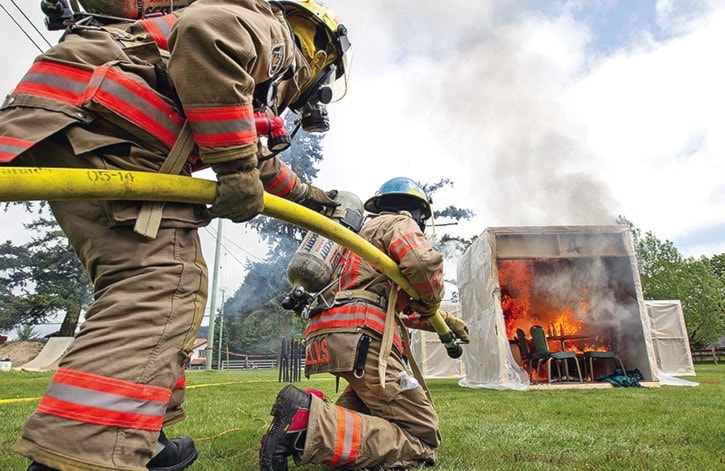Even from 20 feet away, the heat is uncomfortable.
A fire that started in a small cup has slowly eaten up a chair, spewed firey sparks onto a DVD player and crawled up a desk leg, before engulfing an entire cubicle. Within minutes, the fire has devoured the eight-cubic-foot space, prompting firefighters to launch water at the blaze.
This isn’t someone’s home, thank goodness, this is training. Fire investigators who weren’t present for the blaze, now come in blind to meticulously work backwards trying to figure out how it all went up in flames.
“(They see) how fires contribute and possibly start other fires in the room … and that could lead investigators to believe it started in another area … For fire investigators, (this training) is critical,” said Langford Fire Rescue Capt. Lance Caven. “They can take their time, they can go through and see how a fire grows from beginning to end.”
The week-long session was held recently in and around the Metchosin fire hall on Happy Valley Road. It attracted firefighters from around Vancouver Island, including Salt Spring Island, Bowen Island, Langford and Metchosin, with groups alternating between watching the cubicles burn, or coming in afterwards to investigate the cause. Spaces arranged as bedrooms, kitchens and dens were set ablaze to mimic potential fire hazards in real-life situations.
“I like that scientific CSI-ing; figuring things out after the fact, putting facts together to find things out,” said Metchosin firefighter Dylan Walsh. “It’s much better to have natural or as close to real as you can get. Working (only) from books and theory, you don’t get the full understanding.”
Walsh, one of 18 participants, said fitting the puzzle pieces together to get the right answer is extremely challenging. Having the opportunity to do so in a controlled situation is invaluable, both for firefighters and the public, he added.
“It gives us more understanding for future prevention, and the more we understand now, the more we can portray it to residents to not have fires,” he said. “An essential part is the safety and prevention so we don’t have fires (to begin with). Hopefully you don’t have to do the fire investigation, because the end result is not a good thing.”
Cavin said most people don’t understand how quickly fires can burn, or get to ‘flashover’ – the point when it gets so hot in a room that everything ignites and makes survival impossible. With the change in household materials over the years, he said, that timing isn’t increasing, it is actually going down.
“Furniture from years past burned a lot slower. New furniture made of plastics and different materials burns a lot quicker now,” he said. “In years past, we used to tell people you have five minutes to get out of your house. Well now, you may only have two minutes to get out of your house.”
Metchosin Fire Chief Stephanie Dunlop agreed. She said this training, in which representatives from WorkSafe B.C. and Firewise also participated, is all about community safety.
“Some people have a house fire and don’t know how it happened. As a homeowner you want to know and an insurance office will want to know,” Dunlop said. “There are a lot of reasons to know why, so it doesn’t happen again. It’s to everyone’s benefit to have courses like this.”
